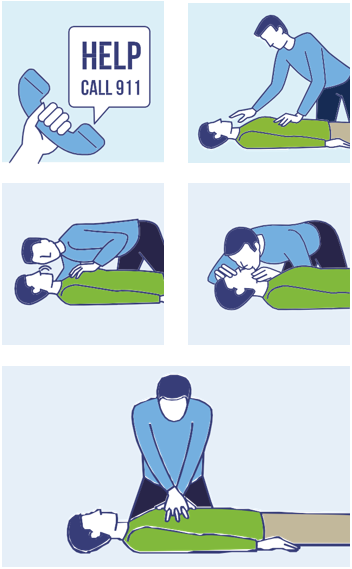 Use this technique if you have had CPR training and are comfortable with the traditional method.
Use this technique if you have had CPR training and are comfortable with the traditional method.
- Verify Scene Safety:
Verify the scene is safe for you and the victim. You do not want to become a victim. - Call:
Check the victim for unresponsiveness. If he or she does not respond to your voice, call 911. Get the automated external defibrillator (AED) if one is available; and return to the victim. The emergency dispatcher will assist you with CPR instructions. - Blow:
Tilt the victim’s head back and listen for breathing. If you do not detect normal breathing, coughing or movement, pinch the victim’s nose and cover the mouth with yours, then blow until you see the chest rise. Give two breaths. Each breath should take about one second. - Pump:
If the victim is still not breathing normally, coughing or moving, begin chest compressions. Push down on the chest at least two inches 30 times right between the nipples. Pump at the rate of at least 100 times per minute, faster than once per second. Allow the chest to return to its normal position between each push. - Repeat:
Continue with the pattern of two breaths and 30 pumps until help arrives. Do not interrupt
Automated External Defibrillators (AEDs)
AEDs are computerized devices that are attached to a victim's chest with wires. An AED can recognize
some heart problems that require electrical stimulation, and gives the heart an electric shock as needed.
With training, AEDs are easy to use. Performing CPR right away and using an AED within a few minutes will increase the victim's chance of survival.
You can learn more about AEDs from the American Heart Association.
